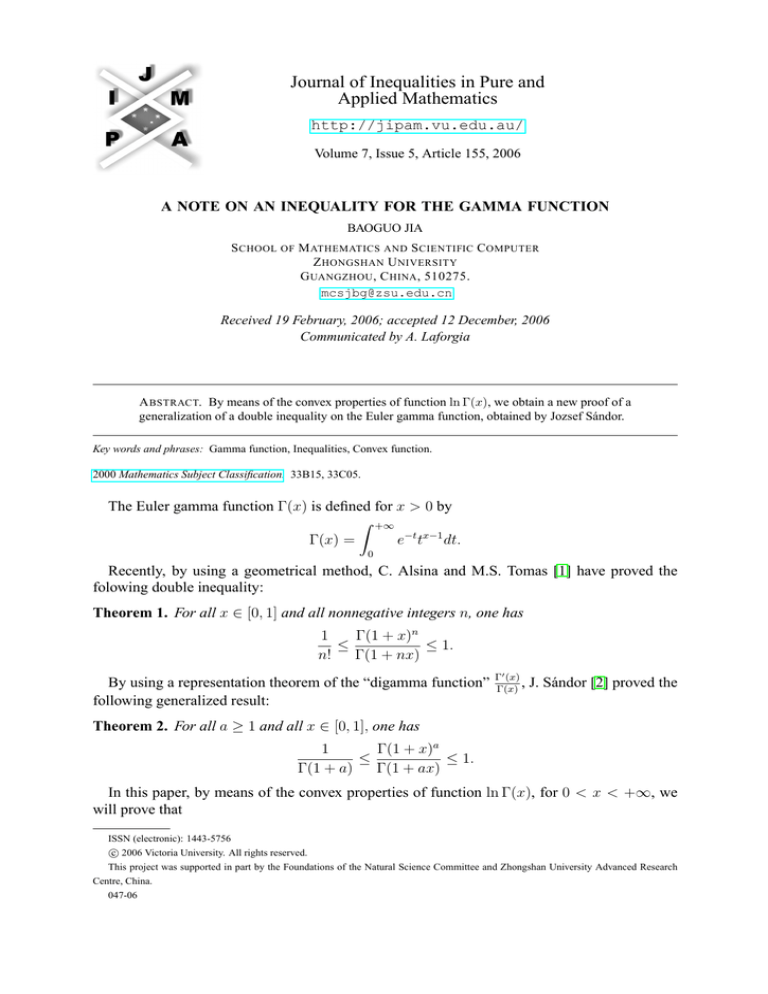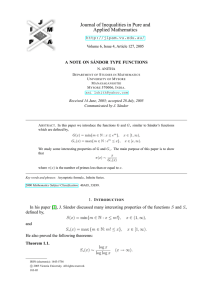
Journal of Inequalities in Pure and
Applied Mathematics
http://jipam.vu.edu.au/
Volume 7, Issue 5, Article 155, 2006
A NOTE ON AN INEQUALITY FOR THE GAMMA FUNCTION
BAOGUO JIA
S CHOOL OF M ATHEMATICS AND S CIENTIFIC C OMPUTER
Z HONGSHAN U NIVERSITY
G UANGZHOU , C HINA , 510275.
mcsjbg@zsu.edu.cn
Received 19 February, 2006; accepted 12 December, 2006
Communicated by A. Laforgia
A BSTRACT. By means of the convex properties of function ln Γ(x), we obtain a new proof of a
generalization of a double inequality on the Euler gamma function, obtained by Jozsef Sándor.
Key words and phrases: Gamma function, Inequalities, Convex function.
2000 Mathematics Subject Classification. 33B15, 33C05.
The Euler gamma function Γ(x) is defined for x > 0 by
Z +∞
Γ(x) =
e−t tx−1 dt.
0
Recently, by using a geometrical method, C. Alsina and M.S. Tomas [1] have proved the
folowing double inequality:
Theorem 1. For all x ∈ [0, 1] and all nonnegative integers n, one has
1
Γ(1 + x)n
≤
≤ 1.
n!
Γ(1 + nx)
By using a representation theorem of the “digamma function”
following generalized result:
Γ0 (x)
,
Γ(x)
J. Sándor [2] proved the
Theorem 2. For all a ≥ 1 and all x ∈ [0, 1], one has
1
Γ(1 + x)a
≤
≤ 1.
Γ(1 + a)
Γ(1 + ax)
In this paper, by means of the convex properties of function ln Γ(x), for 0 < x < +∞, we
will prove that
ISSN (electronic): 1443-5756
c 2006 Victoria University. All rights reserved.
This project was supported in part by the Foundations of the Natural Science Committee and Zhongshan University Advanced Research
Centre, China.
047-06
2
B. J IA
Theorem 3. For all a ≥ 1 and all x > − a1 , one has
Γ(1 + x)a
≤ 1.
Γ(1 + ax)
(i) For all a ≥ 1 and all x ∈ [0, 1], one has
1
Γ(1 + x)a
≤
.
Γ(1 + a)
Γ(1 + ax)
(ii) For all a ≥ 1 and all x ≥ 1, one has
1
Γ(1 + x)a
≥
.
Γ(1 + a)
Γ(1 + ax)
(iii) For all a ∈ [0, 1] and all x ∈ [0, 1], one has
Γ(1 + x)a
1
≥
.
Γ(1 + a)
Γ(1 + ax)
(iv) For all a ∈ [0, 1] and all x ≥ 1, one has
1
Γ(1 + x)a
≤
.
Γ(1 + a)
Γ(1 + ax)
Our method is elementary. We only need the following simple lemma, see [3].
Lemma 4.
(a) Γ(x + 1) = xΓ(x), for 0 < x < +∞.
(b) Γ(n + 1) = n!, for n = 1, 2, . . . .
(c) ln Γ(x) is convex on (0, +∞).
Proof of Theorem 3. When a = 1, it is obvious.
When a > 1, by (c) of Lemma 4, we have
1
1
u v
Γ
+
≤ Γ(u) p Γ(v) q ,
p q
where p > 1, q > 1, p1 + 1q = 1, u > 0, v > 0.
a
Let p = a, q = a−1
. Then
1
1
1
1
Γ
u+ 1− v
≤ Γ(u) a Γ(v)1− a ,
a
a
for u > 0, v > 0.
Let v = 1, u = ax + 1. Note that Γ(1) = 1, a1 u + (1 − a1 v) = x + 1.
We obtain
1
u−1
1
Γ(x + 1) ≥ Γ(ax + 1) a ,
for x =
>− .
a
a
Remark 5. Theorem 3 is a generalization of the right side inequality of Theorem 2.
Proof of Theorem 3.
(i) Let
f (x) = ln Γ(ax + 1) − ln Γ(1 + a) − a ln Γ(x + 1).
Since Γ(2) = 1, We have f (1) = 0.
0
Γ (ax + 1) Γ0 (x + 1)
0
f (x) = a
−
Γ(ax + 1)
Γ(x + 1)
J. Inequal. Pure and Appl. Math., 7(5) Art. 155, 2006
http://jipam.vu.edu.au/
A N OTE ON AN I NEQUALITY FOR THE G AMMA F UNCTION
3
Set h(t)= lnΓ(t). By (c) of theLemma
4, ln Γ(x) is convex on (0, +∞). So (ln Γ(t))00 ≥ 0.
0
0 (t)
0 (t)
That is ΓΓ(t)
≥ 0. Therefore ΓΓ(t)
is increasing. Because a ≥ 1 and x ∈ [0, 1], one has
ax + 1 ≥ x + 1. So
Γ0 (ax + 1)
Γ0 (x + 1)
≥
Γ(ax + 1)
Γ(x + 1)
0
Thus f (x) ≥ 0. In addition to f (1) = 0, we obtain that f (x) ≤ 0, for a ≥ 1 and x ∈ [0, 1].
So (i) is proved.
Note that
ax + 1 ≥ x + 1, for a ≥ 1 and x ≥ 1;
ax + 1 ≤ x + 1, for a ∈ [0, 1] and x ∈ [0, 1];
ax + 1 ≤ x + 1, for a ∈ [0, 1] and x ≥ 1.
So (ii), (iii), (iv) are obvious.
R EFERENCES
[1] C. ALAINA AND M.S. TOMAS, A geometrical proof of a new inequality for the gamma function, J. Ineq. Pure Appl. Math., 6(2) (2005), Art. 48. [ONLINE: http://jipam.vu.edu.au/
article.php?sid=517].
[2] J. SÁNDOR, A Note on certain inequalities for the Gamma function, J. Ineq. Pure Appl. Math., 6(3)
(2005), Art. 61. [ONLINE: http://jipam.vu.edu.au/article.php?sid=534].
[3] W. RUDIN, Principle of Mathematical Analysis, New York: McGraw-Hill, 1976, p. 192–193.
J. Inequal. Pure and Appl. Math., 7(5) Art. 155, 2006
http://jipam.vu.edu.au/












